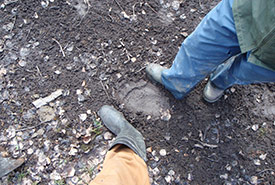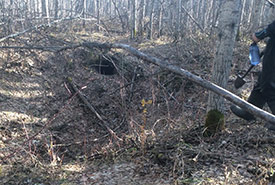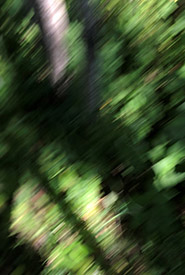Wildlife encounters in rural Saskatchewan

My co-worker and I comparing our feet to prints left by a bear in rural BC.(Photo by Matthew Braun/NCC staff)
Wildlife encounters during my rural Saskatchewan childhood were rare, and you’d have to include cats and dogs and the numerous coyotes surrounding our farm to really pump my numbers up. And while coyotes arguing with dogs during the quiet evenings in my town of Osler still gives me chills, there weren’t many exotic animals on my life-list of cool things I’ve seen.
That’s why I remember, pretty vividly, a childhood school trip to the boreal transition forests of the Prince Albert National Park, about two hours north of the fields and ditches of my home. The bus driver spotted a black bear on the edge of the road, which would have been my closest contact with something really wild, if I hadn’t been trying to hang with the cool kids at the back of the bus and missed it entirely. Even then, just the idea of a bear was exciting enough to sear the memory into my brain.
After completing my degree at the University of Saskatchewan, I got a job with the British Columbia Ministry of Forests and Range, working with ranchers and farmers in the province’s forests and grasslands. I maintained that fascination with wildlife, but my opportunities for observation went up substantially and I started building a collection of photos of my size 12 boots beside the prints and scats of more exciting creatures like wolves, bear and moose.
Working in BC, seeing a bear became more regular, more a part of the scenery. Frequent, even. I started thinking of bears more like I thought of mosquitoes — an annoyance. Something to avoid, but not necessarily fearfully so. “It looks like it could be a heavy bear day!” “Boy, the bears are thick today.” And for the most part, my wildlife encounters stayed at a distance. More than an idea, but less than physical.
When I moved back to Saskatchewan in 2014 to take a land manager/planning job with the Nature Conservancy of Canada (NCC), I thought I’d left my bear excitement behind me, but I was wrong! In 2016, my work managing some of NCC’s forested properties in Saskatchewan had me crashing through the Meeting Lake 03 property on the edge of the Touchwood Hills, surveying forest types in the boreal transition ecoregion.
While meandering the property with my co-worker, Emily Little, and our contractor, Giles, we stumbled on (almost literally!) a pit dug by the crew that cleared the original property right of way. We noticed a large hole in the side of the pit in this otherwise, relatively flat (I’m from Saskatchewan, I know from flat) portion of the property. Now, despite having seen plenty of bears by this time in my career, I’d still never seen an actual bear den before, and I always assumed (hoped?) they were a little more exotic than a hole in the side of a hole. I guess I imagined something classy, like a cave tunnelled smoothly into the side of a mountain, with decorative bushes on either side and a smooth dirt floor.

The den in a pit is the latest home for all discerning black bears of the boreal transition ecoregion. I guess you make do with what you can find if mountain-side caves can't be found? (Photo by NCC)
Once we finally agreed this could only be a bear den (again, den seems a pretty glamorous term. I could agree to calling it a hovel, maybe, a hole definitely, but perhaps, more generously, a burrow.) we had to decide who had to stick their head in to see if anyone was home. I mean, we really didn’t need to check, but how could we resist? I honestly don’t remember who put their head through the cobwebbed entrance, but it was pretty exciting even when it was obvious it was abandoned. It was a chilly fall day, and we didn’t see any wildlife the rest of the day.
Fast forward a couple of years when I was alone on the property conducting ecosystem health assessments to support future decisions to help improve wildlife habitat. It was close to the middle of one of the hottest field days I’ve had. I was crashing around with my eyes on the ground looking for the shrubs, flowers and any signs of soil disturbance to help me describe the ecosystem.
I don’t remember exactly what tipped me off and caused me to put my head up. But when I did, I noticed two black bear cubs being chased up a tree by a mama bear looking as irritable as I felt, but with a bit more muscle to back it up.

Nearly as informative as Chris Helzer's A Field Guide to Roadside Wildflowers At Full Speed. (Photo by NCC)
As she clacked her teeth at me, warning me to stay back, I fumbled in my pocket for my camera to take what would have been the closest/coolest bear photo yet. Of course, I dropped my phone and just had time to pick it up before my heat-addled brain finally kicked in enough to save me from myself and I backed away. I manage one blurry photo of a shrub, which would have been a good action shot to back up a lie about being chased or charged or something by the bear, but no. She and I went our separate ways and I didn’t even get a cool picture.
I don’t want to give people the impression that I wasn’t taking appropriate precautions. I did not get eaten by a bear that entire day! I decided to conduct the rest of my assessments on a different part of the 194-hectare property. Later, I startled a moose and ended up dodging an imaginary animal crashing through the woods (it was still hot, and my brain had given up) by wading through a thigh-deep (that’s waist deep for the rest of you) slough as a shortcut to my vehicle to finish my day. It doesn’t seem like enough to say that we manage some pretty cool lands with unexpected benefits or that you should be careful what you wish for as a kid because you just might get it.
So, my take home message should be obvious by now. “Never leave your childhood home!” No wait, that’s not it. “Bear stories are worth their weight in gold, but the best bear stories are the ones you walk away from.” Close enough, so if you want to continue walking away from bears (slowly, backwards, using soothing tones to keep yourself and the bear from worrying), remember to follow a few tips:
- Make noise while moving through bear country — generally, bears react like any other wildlife by avoiding humans.
- Back away when you do encounter a bear. If you see cubs in a tree, mom is probably near by. Leave the area the same way you arrived.
- Carry bear spray and know how to use it. That was the second time I’d felt the need to unholster my can of bear spray, but when I work alone on properties with bears, it is always at the ready.
Actually, why don’t you go ahead and follow all of these Parks Canada approved tips. The point is, bears are there, but not necessarily a reason for you not to enjoy the out of doors. Get out there and enjoy, but pay attention and learn from my experience.


